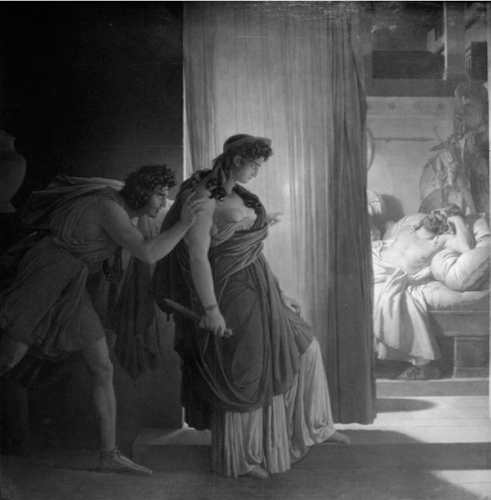Classical Greek MythologyAeschylus and the Oresteia |
What is the plot of Agamemnon? |
The plot—the mythos—of Agamemnon begins with a watchman waiting for the return of Agamemnon from the Trojan War. He speaks ominously of the manlike heart of Agamemnon’s wife Clytemnestra, and the audience knows that she is angry that, before leaving for the war, the king had agreed to follow an oracular instruction that he sacrifice his daughter Iphigenia. Agamemnon now arrives on the scene with his concubine, Cassandra, the daughter of King Priam. Cassandra is cursed with the ability to see the past and the future. Clytemnestra manages to convince Agamemnon to enter his palace by walking on a purple carpet as a conquering hero, an act of extreme pride or hubris, a sin which characterizes tragic heroes in Greek drama. Left outside, Cassandra wonders whether to follow. In a soiloquy, she relates some of the horrors of the House of Atreus that she foresees; she realizes what will happen to her and Agamemnon inside the palace. Nevertheless, she enters. Soon there are bloodcurdling cries and the butchered bodies of Agamemnon and Cassandra are displayed to the chorus, representing the people of the polis—the city. Clytemnestra arrives with the bloodied axe used in the execution of her husband. Her lover, Aighistos—the cousin of Agamemnon, whom the king had left to guard his kingdom in his absence—accompanies the queen and speaks with arrogant hubris. The chorus warns of the inevitable return of Agamemnon’s son, Orestes, who will certainly act in revenge in the age-old tradition of blood for blood. The mythos of the play involves, in effect, only an hour or so of Agamemnon’s complex life. This tiny segment of a life will lead the audience to pity the hero on one hand, but to sit in fear—that is, awe—as it contemplates the horrors of his sin, that of his wife and her lover, and those of the House of Atreus as a whole. The prospect of a neverending blood feud within a family and a society would not have been a prospect with appeal to a law-based city-state such as Athens.

An 1817 painting by Pierre-Narcisse Guérin shows Clytemnestra, encouraged by Aighistos at far left, about to kill Agamemnon.
